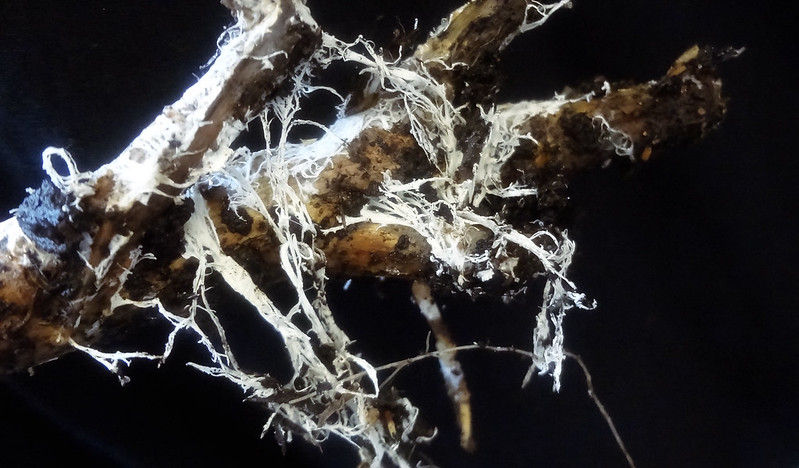Go Ask A Mushroom
Musings on Afterculture
By Natalia Borissova
What possible intelligent natural systems can we look to for inspiration and guidance in the patterning of our human living environments, and for sketching out a kind of positive vision for a coming “afterculture”? How can we innovate more naturally? Assuming that humans are not the only artful organisms on this planet, I am interested to look into “other intelligence” in relation to resilient life after culture. Granted, there’s nothing new in assigning to the “mushroom” the role of a multifunctional “world healer,” nor in trying to engage this keen organism in the remediation of culture, but still – when talking about collaboration, art and life, we can’t overlook the lowly mycelium (the vegetative part of a fungus).
“We are born from fungi. 600 million years ago we separated from fungi. Fungi are our ancestors.”
– Paul Stamets (Living Green Interview)
Spawning the resilium
In nature, mycelium links all the elements of the ecosystem together simply by carrying on its usual life cycle. It unlocks nutrient sources stored in plant's cells and other organisms, through decay and converts the organic matter into a more usable form, redistributes nutrients to wherever they are most needed, fertilises the soil and maintains its diversity. It does essential life-enhancing work at the grassroots in constant dialogue with the environment. Human intervention damages wild nature, artificial fertilizers cause mycelia to retreat and the soil to lose its vibrancy. But mycelial networks are resilient and are able to survive catastrophes, re-grow, convert inorganic matter into organic usable form for themselves and for other organisms. They can remediate poisoned lands, decompose toxic wastes and radioactive pollutants. So, if fungi can thrive even on toxins, why not look to them in the remediation of societies and the mycofiltration of contemporary cultures that are often poisoned by relentless abuse of power and polluted by late capitalist values.
I believe one of the most significant problems with contemporary culture is that it over com.modified – tends to focus on the “objects” themselves – surface appearances and formal pragmatic constructs – rather than on relationships between the varying parts and how they treat each other. These relationships are what turn a collection of unrelated “matter” into a self functioning whole. By cultivating relationship we can save resources, energy, labour, not to mention ourselves, and work towards creating a holistic society.
What if we inoculate culture with a mycorrhizal, medicinal, gourmet and magic mushroom cultures to generally enhance its health and imagination? And then when the right conditions emerge, multifarious fruits will rise up to “poison” the world with beauty, and seed other mycelia that further propagate through “fresh” territories. When the mycelium exhausts its food sources in one area it expands outward in a circular fashion and cannibalizes the mycelium within to extract whatever nutrients it can find there to move them to the outer, growing regions. Whatever cannot be recycled is closed off and allowed to decay. May be it's time to ingest the inner core of our decaying culture, extract whatever nutrients remain, and redistribute them according to the true needs?
By analogy with mycelium, a “resilium” could be compared with a resilient tissue which randomly spreads out widely through time-space, pops up in the most unexpected places and sparks joyful illumination. It adsorbs complex reality upside down, digests it externally by releasing enzymes of curiosity, amazement, and other magical compounds. It inventively converts it into non-discriminative knowledge and makes all this available for other organisms to feast on. This method of releasing enzymes and providing food for for yourself and others is the natural way the resilium exists. When enough nutrients are collected in its network, fruiting bodies emerge – mountain bear missions, remote sensing flight operations, augmented and non-green harvests, flotilla feasts, and many other unique happenings happen. These materialisations respond to prevailing conditions and circumstances, and can be repeated in various forms as creatures from all walks of life join in. The vaster the resilium, the more extravagant the “fruiting bodies” emerge. When the “fruits of resilium” die down, the essential part of the organism is still alive. And it is not a static object, it grows selectively in response to all chemical signals of human and nonhuman entities around it.
From mono to poly
What kind of environmental layout or design could be called “nature-logical”? I would say that it is an “open” one that links many possible organisms into one heterogeneous kingdom of useful relationships and mutually beneficial connections among microbes, fungi, plants, insects, birds, mammals, and all the other inhabitants of our world, including the human species; each individual organism has multiple roles and is interconnected within the system; edges are optimised and all resources are reused; problems, limitations and mistakes are embraced creatively, and the environment thrives; there is no need to impose artificial connections from the outside. This self-sustaining approach differs from the formal and monocultural one, where the parts are mostly disconnected from each other, serve a single purpose, require a lot of labour and resources to maintain. We are in fact the sometimes disconnected parts of one natural whole.
Let's hallucinate that by elaborating these models and principles, the human addiction to domination and the “mono” attitude can gradually change in favour of dynamic rotations, symbiotic communities, and altered senses of reality…
